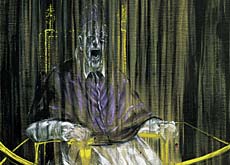
Bacon at the Beyeler reveals artist’s influences

The Beyeler Foundation is presenting a major retrospective of works by Francis Bacon that is almost as unconventional as the artist himself.
It places Bacon’s oeuvre for the first time in the context of earlier art, from the Old Masters up to Picasso.
The exhibition in Riehen, near Basel, gives a fascinating insight into the broad brush of artists who inspired the Dublin-born artist, including Titian, Velázquez, Rembrandt, Ingres, Degas, and Alberto Giacometti. Filmmakers such as Sergei Eisenstein and Luis Buñuel also played a role.
Freelance curator Barbara Steffen told swissinfo that Bacon – one of the 20th century’s most original painters – was happy to acknowledge all these influences.
“He was not trained at art school and began educating himself from an early age,” she explained. “He studied Greek architecture, Egyptian sculpture and could speak French, Greek and Spanish.
“I think the biggest influence was Picasso. It was after seeing a series of Picasso drawings in Paris in 1928 that he began producing his own drawings and paintings.”
Bacon was later spurred on by the Bauhaus movement.
“He worked as a furniture designer in the Bauhaus style in the late 1930s and early 1940s. But when he gave that up, Bacon destroyed much of his work… furniture, drawings and paintings.”
Face of horror
By the mid-1940s Bacon was starting to become well-known and in 1953 he sent shockwaves throughout the art world with his “Study after Velazquez’s Portrait of Pope Innocent X” – which is included in the exhibition.
Steffen says his often disturbing papal pictures reflect a fascination with “the face of horror” dating back to experiences during his youth.
“Bacon’s father was a powerful figure who threw him out of the family house in Dublin after his homosexuality became known when he was just 16.”
From then on, apart from his foreign travels to further his art education, Bacon was based in London.
Screaming pope
The Riehen exhibition takes a thematic approach to Bacon’s oeuvre, with sections devoted to his portraits of popes, the motif of the scream, Surrealism, van Gogh and the triptych as a painting genre.
Major works on display include several of Bacon’s famous triptychs – Three Portraits: Posthumous Portrait of George Dyer, Self-Portrait, Portrait of Lucian Freud – in addition to several versions of the screaming pope, and variations on a mutilated self-portrait by van Gogh.
Organised in conjunction with the Kunsthistorisches Museum, Vienna, the exhibition was conceived and curated for both venues by Steffen. It is at the Beyeler Foundation until June 20.
swissinfo, Richard Dawson in Riehen
Born in Dublin in 1909, Bacon lived in London until his death in 1992.
He was not trained at art school and began teaching himself from an early age.
He studied Greek architecture, Egyptian sculpture and could speak French, Greek and Spanish.
The exhibition places Bacon’s oeuvre for the first time in the context of its links with earlier art, from the Old Masters through to the 20th century.

In compliance with the JTI standards
More: SWI swissinfo.ch certified by the Journalism Trust Initiative





























You can find an overview of ongoing debates with our journalists here . Please join us!
If you want to start a conversation about a topic raised in this article or want to report factual errors, email us at english@swissinfo.ch.